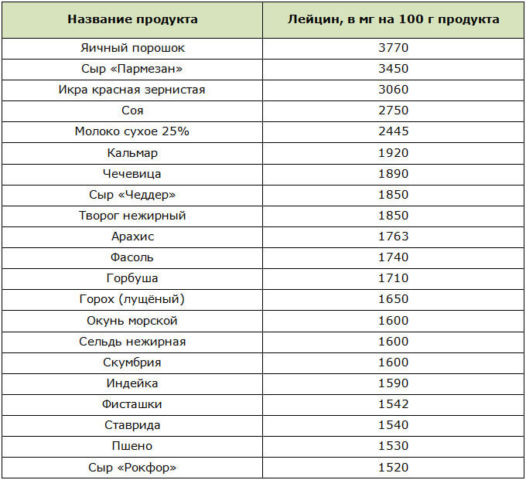Content
To maintain adequate functioning of organs and systems, amino acids are required. The most valuable are irreplaceable substances that come exclusively from food. They cannot be synthesized in the body. Leucine is found in foods in various concentrations.
The role of leucine in the body
The aliphatic amino acid is represented by the formula HO2CCH (NH2) CH2CH (CH3) 2. Colorless powder (in pure form) dissolves in acids and alkaline media. The organic compound is hydrophobic. The main property of foods that contain the substance is to build muscle tissue.
Leucine is processed by both the liver and adipose tissue. An irreplaceable organic compound that stimulates protein synthesis. Regular intake of appropriate foods slows down muscle degradation.

It is noteworthy that the amino acid can be synthesized from soy (plant material) or milk proteins. Bioavailability is about 96%. The kidneys, pancreas, spleen and liver are involved not only in the processing but also in the absorption of leucine. The excess substance is excreted through the urinary system.
Leucine is considered one of the most important organic compounds. An essential amino acid performs the following functions:
- stimulates insulin production;
- promotes the growth and adequate development of muscle tissue, prevents the violation of their integrity;
- accelerates the regeneration processes;
- supports the level of serotonin, which is the hormone of joy.
An organic compound is energy efficient for cellular elements. The amino acid is involved in the production of hemoglobin, protein.
The following useful properties are called:
- normalization of sugar levels;
- strengthening the immune system and the musculoskeletal system;
- normalization of the liver;
- reducing the risk of obesity;
- increased efficiency by reducing fatigue.
The intake of amino acids in the body has a beneficial effect on the skin. Leucine helps to eliminate cellulite and improves general condition in the following pathologies:
- malignant tumors;
- sepsis;
- extensive injuries;
- liver disease.
Leucine is used as part of complex therapy for renal failure, poliomyelitis, liver cirrhosis.
Causes and signs of leucine deficiency
The daily requirement for an essential amino acid is 4 to 6 g. This amount is contained in the following items:
- 3 eggs;
- 100 g of cottage cheese;
- 200 g of beef;
- a glass of milk (kefir).
An increased amount of the substance is required for active physical and mental stress. Otherwise, a deficiency of organic compounds may occur, which will negatively affect the state of health and well-being.Amino acid deficiency is also observed with an unbalanced diet, lack of a sufficient amount of animal products in the diet.
Deficiency conditions are the most dangerous for a growing child's body. Insufficient intake of the substance impairs physical and intellectual development. That is why it is important to provide balanced nutrition to your child.
Deficiency of organic compounds in adults is manifested:
- obesity;
- pathologies of a mental nature;
- dysfunctions of the liver, thyroid gland;
- impaired renal function.
Lack of leucine provokes hypoglycemia.
What foods contain the amino acid leucine
The compound can only be ingested with food. A balanced diet with the inclusion of predominantly animal products in the diet is essential.
The main sources of the substance include:
- egg powder;
- soy protein concentrate;
- caviar;
- cheeses;
- seafood (squid);
- legumes (beans, peas);
- fish (perch, mackerel, pike perch, pike, herring);
- meat (turkey, beef, lamb, lean pork);
- nuts (peanuts, hazelnuts, almonds, sesame seeds, pistachios);
- sunflower seeds;
- chicken egg;
- corn grits.
Minor amounts of organic compounds include mushrooms, vegetables and fruits.
Guidelines for choosing and taking products containing leucine
The presence of the substance in food is ambiguous. Leucine is found primarily in animal products. However, plant sources, such as legumes and cereals, also provide its intake. Meals should be as balanced as possible and include different names.
Foods high in leucine are important during intense exercise. Careful preparation of the children's menu is essential. Deficiency of an organic compound can cause serious developmental problems in a child.
Leucine content tables in different foods
The organic compound is found in both animal and plant sources. The leucine content in foods is reflected in the tables:


Signs of excess leucine in the body
Not only the deficiency of an irreplaceable substance is harmful to health. An excess of a compound in the body can provoke the following unpleasant consequences:
- impaired liver function;
- muscle tissue atrophy;
- disorders associated with the nervous system (drowsiness, depression, headaches);
- allergic reactions;
- low blood sugar or hypoglycemia.
Who shouldn't take leucine-rich foods
The substance is not recommended for use with certain hereditary pathologies that are associated with a metabolic disorder of this organic compound:
- leucinosis;
- isovaleratacidemia.
For these diseases, products containing organic compounds and other hydrophobic amino acids should be excluded.
Conclusion
The leucine contained in foods has a beneficial effect on the body. An essential amino acid that supports muscle tissue, the functioning of various organs and systems. However, both deficiency and excess of organic compounds are harmful to health.

